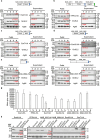Deletion of ESX-3 and ESX-4 secretion systems in Mycobacterium abscessus results in highly impaired pathogenicity
- PMID: 39900631
- PMCID: PMC11791044
- DOI: 10.1038/s42003-025-07572-4
Deletion of ESX-3 and ESX-4 secretion systems in Mycobacterium abscessus results in highly impaired pathogenicity
Abstract
Type VII secretion systems participate in protein export, virulence, conjugation, and metabolic regulation. Five subtypes (ESX-1 to ESX-5) exist, each with specific roles and well-characterized secretion profiles in various mycobacterial species. Mycobacterium abscessus, encodes only ESX-3 and ESX-4. Here, single and double M. abscessus mutants lacking the main ATPases EccC3 and EccC4 were used to define ESX-3 and ESX-4 contributions to substrate secretion and virulence. Our results demonstrate that EsxG/H secretion depends entirely on ESX-3, whereas both ESX-3 and ESX-4 secrete EsxU/T. Furthermore, two newly identified PE/PPE substrates (MAB_0046/MAB_0047) require ESX-3 for secretion. Functional complementation restored secretion and revealed subpolar localization of these systems. Macrophage infections showed that ESX-3 and ESX-4 contribute to bacterial internalization, phagosomal escape, and intracellular survival. In mice, infections with eccC3- and/or eccC4-deletion mutants resulted in complete survival and reduced bacterial loads in the lungs. These findings demonstrate that both ESX systems drive M. abscessus pathogenicity.
© 2025. The Author(s).
Conflict of interest statement
Competing interests: The authors declare no competing interests.
Figures







References
-
- Pym, A. S., Brodin, P., Brosch, R., Huerre, M. & Cole, S. T. Loss of RD1 contributed to the attenuation of the live tuberculosis vaccines Mycobacterium bovis BCG and Mycobacterium microti. Mol. Microbiol. 46, 709–717 (2002). - PubMed
MeSH terms
Substances
Grants and funding
- 19-CE15-0012-01; SUNLIVE/Agence Nationale de la Recherche (French National Research Agency)
- Equipe FRM EQU202103012588/Fondation pour la Recherche Médicale (Foundation for Medical Research in France)
- Antimicrobial Resistance 202309ARB/Gouvernement du Canada | Canadian Institutes of Health Research (Instituts de Recherche en Santé du Canada)
LinkOut - more resources
Full Text Sources
Medical

